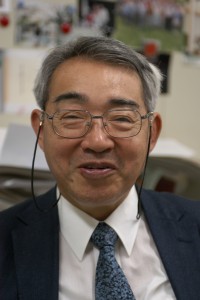The European Physical Society Accelerator Group announced that Shin-ichi Kurokawa, professor emeritus at KEK, Japan, and vice president of Cosylab, was awarded the Rolf Widerøe Prize, which is given to an individual for his or her outstanding work in the particle accelerator field.
Kurokawa has been working in the accelerator field for 37 years. “I was not an accelerator physicist originally,” said Kurokawa. He was an experimental physicist, working on particle physics experiments using low-energy kaon and anti-proton beams. “I started to engage in the construction of KEK’s proton synchrotron beamlines in the early ’70s,” said Kurokawa. He played a central role in the design and construction of beamlines, which caused him to gradually shift his attention to accelerator physics.
He exercised outstanding leadership in many projects at KEK. He was in charge of accelerator control in the TRISTAN project, and he led the successive project, the KEK B-Factory, as a project leader. “We had an electron cloud problem at the beginning of the KEKB commissioning, and could not reach the luminosity we aimed at,” said Kurokawa. To deal with the situation, he employed solenoid coils on the beam pipes. That decision greatly contributed to the later accomplishment of a luminosity world record at the KEK B-factory.
His contribution to accelerator physics extends to international collaboration. He actively participated in international frameworks in Asia such as the Asian Committee for Future Accelerators. He served on the committee since its establishment in 1996, and led the organization as chair from 2004 to 2006.
Kurokawa always says “strengthening the relationship between Asian countries and regions such as China, Korea, India, Taiwan and Japan is crucial for accelerator science to be more actively pursued.” His conviction motivated him to promote numerous collaborative research programs within Asia. He also worked to build collaborative relationships between Asian and Middle Eastern countries in the synchrotron radiation research field, establishing a framework to provide Japan’s accumulated knowledge and expertise in the field to young Middle Eastern and African researchers at SESAME (Synchrotron light for Experimental Science and Applications in the Middle East) in Jordan. He was instrumental in the creation of APAC (Asian Particle Accelerator Conference) in 1998.
In addition, he successfully convened the first IPAC meeting. IPAC, or the International Particle Accelerator Conference, once had three different names, being separately organised in three regions: PAC in the Americas, EPAC in Europe, and APAC in Asia. He made a great effort to merge them into one international conference and chaired the first IPAC successfully in Kyoto in May 2010.
His contribution to the ILC is also significant. Kurokawa chaired the organising committee for the very first International Linear Collider school held in Hayama, Japan, in 2005. He also was the recipient of the Reference Design Report for the ILC as Chair of the International Linear Collider Steering Committee in Beijing in 2007.
Looking forward to the completion of the ILC Technical Design Report in 2012, Kurokawa said, “The important thing is to evolve the Global Design Effort into a more structured organisation. The new organisation should stand on more a rigid international framework.”
He will receive the medal for the Rolf Widerøe Prize this September at the second IPAC conference, to be held in San Sebastian, Spain.
Read the full statement from the European Physical Society


Dear Prof. Kurokawa,
Heartiest Congratulations!
With warm regards + best wishes
Sameen Ahmed KHAN
Engineering Department
Salalah College of Technology,
Salalah, Sultanate of OMAN.
http://SameenAhmedKhan.webs.com/